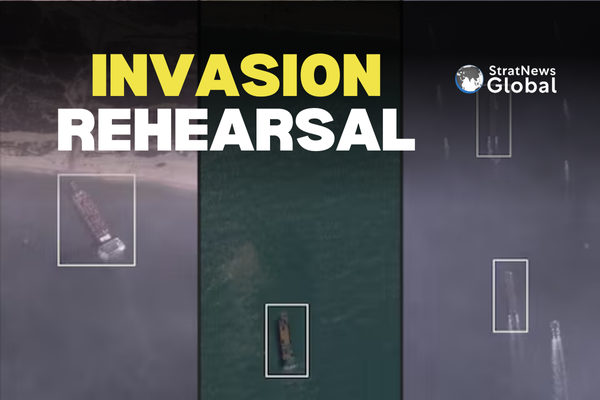China’s military has been practising for a potential invasion of Taiwan using a fleet of civilian cargo ships and ferries, according to a Reuters investigation that analysed satellite imagery and vessel movements from large-scale exercises held this summer.
The report reveals that the People’s Liberation Army (PLA) is experimenting with methods to rapidly land troops and equipment on multiple Taiwanese beaches at once a tactic that military experts say could overwhelm the island’s defences in the event of an attack.
Satellite imagery showed 12 civilian ships, including six roll-on, roll-off car ferries and six deck cargo vessels, conducting beach landings near Jiesheng in China’s Guangdong Province in August. Some were observed unloading vehicles directly onto the sand via built-in ramps. Analysts described this as a significant development in China’s amphibious warfare capability.
The exercises also featured a floating pier system, last seen in 2023, that could allow China to unload troops and supplies quickly even if Taiwan’s ports were destroyed. Naval experts said this suggests China is continuing to refine logistics infrastructure crucial to any invasion plan.
Expanding Amphibious Capability
Military analysts estimate China’s existing amphibious fleet could transport only about 20,000 troops in an initial assault far fewer than the 300,000 to one million troops that would likely be needed. The ability to commandeer civilian vessels could therefore greatly expand China’s invasion capacity.
“China’s commercial shipbuilding industry accounts for more than half of global shipbuilding,” the report noted, compared to just 0.1% for the United States. The PLA has the legal authority to requisition civilian ships, effectively giving Beijing access to vast additional transport resources in a conflict.
“It means that their amphibious lift capability is much greater than it appears to be,” said Ian Easton of the US Naval War College.
Taiwan and US Reactions
Taiwan’s Defence Minister Wellington Koo said in September that the island maintains “continuous oversight” of China’s use of roll-on, roll-off vessels and has developed “relevant contingency plans.” Admiral Lee Hsi-min, former chief of Taiwan’s armed forces, told Reuters the drills demonstrated China’s ability to conduct “multi-point, small amphibious landing operations” that could stretch Taiwan’s defences.
However, one senior Taiwanese defence official, speaking anonymously, questioned the effectiveness of using unarmed civilian ships in an invasion, noting they would be highly vulnerable to portable anti-ship and anti-tank weapons. The official suggested the exercises may also be a form of “cognitive warfare” psychological operations intended to intimidate Taiwan and its allies.
In Washington, a White House spokesperson said the US policy remains to maintain Taiwan’s defensive capability “relative to that of China,” adding that President Donald Trump believes Beijing will not attempt an invasion while he is in office.
Beijing Reaffirms Position on Taiwan
China’s foreign ministry reiterated its stance that Taiwan is an internal matter. “The Taiwan question is purely an internal affair of China,” it said. “We will never allow any force to separate Taiwan from China by any means.”
Taiwan’s government rejects Beijing’s sovereignty claims, and polls consistently show that most of the island’s 23 million residents oppose unification.
Retired Taiwanese naval officer Yuster Yu said the findings show China’s preparations are becoming increasingly concrete. “This kind of thing worries me more than their aircraft carriers,” he said. “It shows they are serious about putting troops on the ground.”
(with inputs from Reuters)





